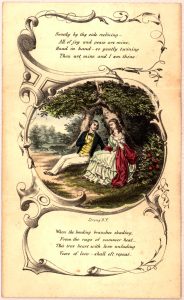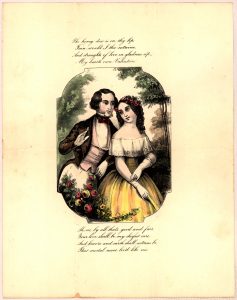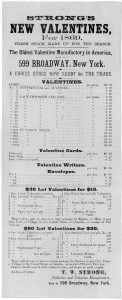Thomas W. Strong was a New York City publisher of popular lithographs and the self-proclaimed “oldest manufacturer of valentines in America.” It seems only fitting that he manufactured countless valentines as St. Valentinus, for whom the holiday is named, since “valens” means “strong” in Latin. This month, I’m featuring a broadside (a large sheet of paper used primarily for announcements or advertisements) and two additional supporting ephemeral items that are both likely from Strong’s printing press. All three of these items reside in the Rare Book and Special Collection Division’s Printed Ephemera Collection.
 The 1869 broadside shown at left is a quaint and informative representation of what the printer might offer and, in turn, how Valentine’s Day might have been observed and expressed in the mid to late 19th century in the United States. This particular advertisement appears to be intended for wholesalers as the broadside addresses “the trade” and encourages dealers to “send in their orders at once to secure an early supply” with valentines available in bulk lots ranging in price from $10 to $20 with “fresh stock made up for the season.”
The 1869 broadside shown at left is a quaint and informative representation of what the printer might offer and, in turn, how Valentine’s Day might have been observed and expressed in the mid to late 19th century in the United States. This particular advertisement appears to be intended for wholesalers as the broadside addresses “the trade” and encourages dealers to “send in their orders at once to secure an early supply” with valentines available in bulk lots ranging in price from $10 to $20 with “fresh stock made up for the season.”
A wide array of valentines were offered ranging from comic to sentimental, juvenile or adult and plain or fancy. Decorated valentines were available adorned with lace, gilt or embossing. Fancy boxes were also an option.
One such specimen of a Strong valentine appears in the online Printed Ephemera Collection with the date of 1840.
This valentine, shown above right, features a young couple seated under a tree, while the young male suitor professes his genteel and heartfelt sentiments:
Sweetly by thy side reclining— All of joy and peace are mine, Hand in hand—so gently twining Thou art mine and I am thine.
Where the bending branches shading, From the rays of summer heat—This true heart with love unfading Vows of love—shall oft repeat.
The lucky recipient of this Valentine’s Day card would be assured of her suitor’s steadfast dedication and love.
Although the next item is not identified as a Strong valentine, it bears a remarkable similarity to the item above and shares the same printing date. This particular valentine expresses a more passionate sentiment, somewhat reminiscent of the ardor in the Song of Solomon:
 The honey dew is on thy lip, Fain would I thee entwine, And draughts of love in gladness sip—My heart’s own Valentine.
The honey dew is on thy lip, Fain would I thee entwine, And draughts of love in gladness sip—My heart’s own Valentine.
Ah, no, by all that’s good and fair, Your love shall be my chiefest care, And heav’n and earth shall witness be, That mortal never lov’d like me.
We can only hope that the sentiments expressed were well received by the recipient!
The valentines and advertising broadsides found in our online Printed Ephemera Collection date from the 17th century through the present day. The term “ephemera” includes all printed items meant for short-term use: posters, playbills, song sheets, notices, invitations, proclamations, petitions, manifestos, ballots, tickets, menus, business cards and so on.
The collection items serve as a time capsule, offering a valuable window on times and events gone by. They offer insights relating to the key events of American history, including the Revolutionary War, slavery, the western land rush, the Civil War, women’s suffrage and the Industrial Revolution, as well as the day-to-day existence of those that lived before us.
We are fortunate to have such a large and wonderful ephemera collection thanks to Peter Force, an avid collector of American artifacts and monographs. The Library of Congress acquired his collection in 1867, and it has served as the basis of the Printed Ephemera Collection. The collection boasts more than 28,000 items, 10,172 of which are digitized and available online. Future releases will continue to make more items available.
Although the way life is lived has changed in many ways through the years, a look at love in the 19th century proves that some things remain the same with each generation believing, in the words expressed on the valentine above:
And heav’n and earth shall witness be, That mortal never lov’d like me.















